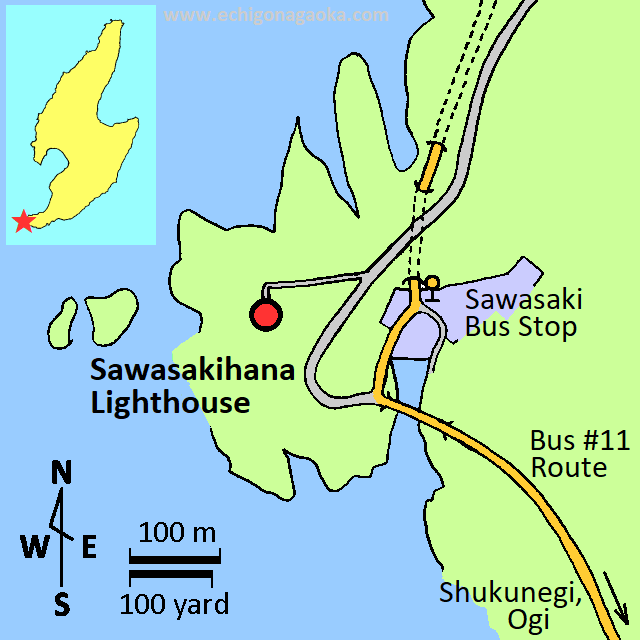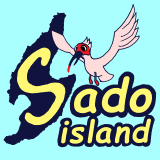echigonagaoka> Sado Island> Sawasaki-hana Lighthouse

Sawasaki-hana Lighthouse
How to get
Get on a #11 bus (Shukunegi-sen) at Ogi. Only a few buses run for route #11. So check the time table carefully beforehand. Just before reaching the lighthouse, the bus turns right when it has crossed a bridge at Sawasaki. You can ask the bus driver to stop at bridge end and to let you get off so that you don’t have to walk upslope from Sawasaki village. It would be better for you to tell the driver that you will get on the bus again when the bus turns back to Ogi.

Photo.48.1 Sawasaki-hana Lighthouse
Sawasakihana Lighthouse is at the tip of Ogi peninsula, or Misaki. The lighthouse is white with octagonal cross section. Below the lighthouse is there tableland of basalt. Although this website has not confirmed, a book says that you can see pillow shape rocks around there. The rocks were shaped when basaltic lava flew into the sea and cooled down by the water1).
This area seems to be the place where people made the first landing on Sado in ancient times, especially for people from Noto peninsula of the mainland Honshu2). There is Remain of ancient village, "Choujaga Daira Iseki", on the ridge of Ogi peninsula. Excavation research of Choujaga Daira Remain was done in 1980 to 1982. Huge amount of artifacts were found by the excavation3).
Now look at the definitions of historical eras/ages in ancient Japan; chronologically, Kyusekki is the oldest, next Joumon, and then Yayoi. Kyusekki Age, or Paleolithic Period, is defined in Japan as before-Joumon age. Joumon Age started in B.C.E.12,000/14,500 and ended in 2 or 3 century B.C.E. It is the age of hunting and fishing before farming started. Joumon was named after the pattern of earthen wares of the time. To make a pattern on the surface of earthen wares, rope was pressed before burning the wares. Yayoi Age started in 2 or 3 century B.C.E. and ended in 3 century C.E. Farming was introduced by people came from the continent. In the end of Yayoi age, several tens of small countries arose in Japan. They were eventually seeking unification as a state country 4).
So the issue is when people came to Sado Island, or how old we can date back to the oldest Sado inhabitants. A book in 1993 says that relics indicate that people were already on Sado in the late Paleolithic Period. Estimated year ranges from 21,000 to 14,000 years ago6). It is based on the fact that stone tools of Choujaga Daira Remain were found just on a layer of the volcano ashes. That volcano ash came from Aira Caldera of Kagoshima Bay in 22,000 - 21,000 years ago, covered most area of Japan7).
But another book in 2003 says that it is not clear whether or not people were living in Sado in ages of Paleolithic Period through the early Joumon age. Although the stone tools of late Paleolithic Period were found in Choujaga Daira Remain and Hasshouga Daira Remain, they were found together with relics of Joumon Ages8). Sometimes we think "the older, the better" for ancient history, but it is always good to be careful. Referring to the book in 20039), this website puts '14,000 - 12,000 years ago' at the top of the chronological list on the page of "Sado Gold and Silver Mine Site".
Putting historical issues aside, this website recognizes that shape of Sado is 'Skewed H'. This implies that there are four lighthouses at each horn. Three appear in this website; Himezaki, Sawasakihana, and Hazikizaki, while one is still missing, which is Daigahana lighthouse. Of the three, this Sawasakihana Lighthouse is the most beautiful with surrounding scenery. It is good to take a picture here as Photo.48.2

Photo.48.2 Sawasaki-hana Lighthouse
